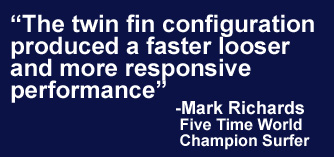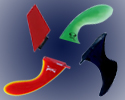Fin Setups
The Twin Fin Setup
 The twin fin surfboard offers increased speed and maneuverability while also being more stable than a single fin. This board design also produces a looser board than a thruster. You will see a twin fin setup on a traditional fish or a more modern shortboard shape.
The twin fin surfboard offers increased speed and maneuverability while also being more stable than a single fin. This board design also produces a looser board than a thruster. You will see a twin fin setup on a traditional fish or a more modern shortboard shape.
Four time world champion Mark Richards believes this board’s performance was directly responsible for his competitive surfing success. When asked about why he liked riding a twin fin, he responded, "The extra tail width of the twin fin gave me more flotation and the twin fin configuration produced a faster looser and more responsive performance, which allowed me to really attack a wave."
 Placement can be found in a number of variations. The most common way the setup is used is to place two fins close to the rails about a foot from the tail of the board. The fins will have a moderate toe-in and cant. This is not the only way twin fins are set up however. Over time shapers have experimented with everything from placing the fins closer to the stringer to setting them straight vertical with no cant at all.
Placement can be found in a number of variations. The most common way the setup is used is to place two fins close to the rails about a foot from the tail of the board. The fins will have a moderate toe-in and cant. This is not the only way twin fins are set up however. Over time shapers have experimented with everything from placing the fins closer to the stringer to setting them straight vertical with no cant at all.
The shape of the fins used on a twin fin setup can range from tall and thin to short and wide. On a traditional fish you might find two very wide fins with large surface areas. Twin fins are commonly used on fish boards with swallow tail designs but are not limited to these shapes. They can also work effectively with round pin and or wider round tail shapes.
Strengths
The twin fin ranks high for maneuverability. A twin fin can practically turn on a dime. When making a turn, one fin will act at the pivot point while the other spins around it. The result is a board that will go exactly where you point it. The twin fin is also known for being very fast. It doesn't have a trailing center fin producing drag which means the board can speed down the line.
Weaknesses
The twin fin is criticized for not providing enough control in sizable conditions. During a powerful bottom turn, the board is likely to slide out and loose control. Twin fins are also tough to use in barreling conditions as it is difficult to track while inside the barrel and the fins might slip free.
Best Conditions
A twin fin works best in conditions from 1-6ft. The looseness of the setup makes it one of the best for sloppy conditions between 2-4ft but a skilled surfer can utilize a twin fin in steep 5-6ft+ conditions.
Conclusion
Twin fins offer a maneuverable and fast ride to surfers. Their quickness and ability to make sharp turns makes them a great choice for small conditions, but they can also be used in medium sized clean surf.















3 Comments